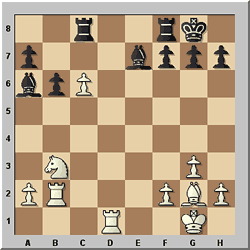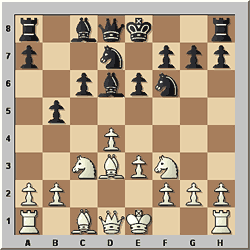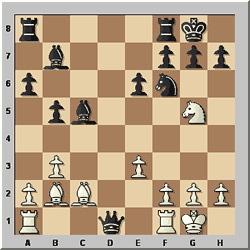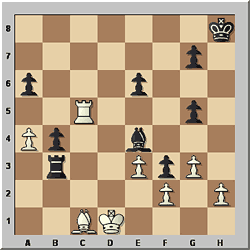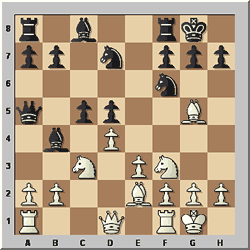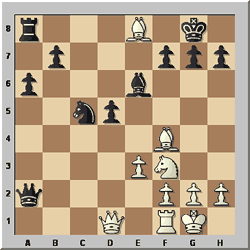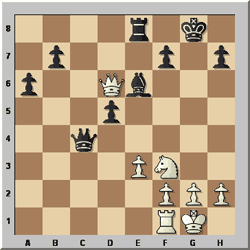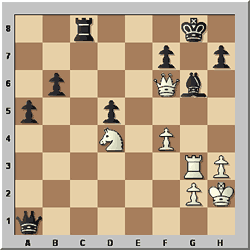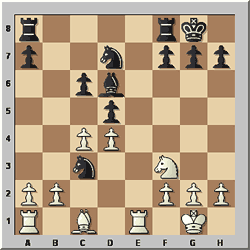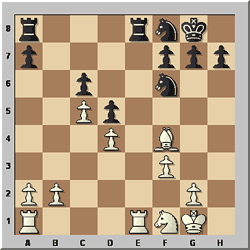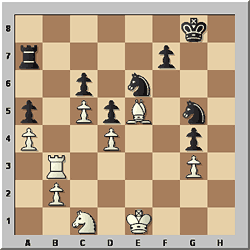
Round three
Round 3: Monday, February 19th |
Veselin Topalov |
½-½ |
Peter Leko |
Peter Svidler |
½-½ |
Vassily Ivanchuk |
Magnus Carlsen |
0-1 |
Vishy Anand |
Alex. Morozevich |
½-½ |
Levon Aronian |
|
|
Round 4: Wednesday, February 21st |
Peter Leko |
|
Levon Aronian |
Vishy Anand |
|
Alex. Morozevich |
Vassily Ivanchuk |
|
Magnus Carlsen |
Veselin Topalov |
|
Peter Svidler |
Games – Report |
|
Standings after three rounds
Commentary by GM Mihail Marin
The following express commentary was provided by Romanian GM Mihail Marin,
who is the author of a number of very popular ChessBase training CDs and articles
for ChessBase Magazine. GM Marin will study the games of the Morelia/Linares
tournament in greater detail and provide the full results of his analysis in
the next issue of ChessBase
Magazine.

Topalov vs Leko at the start of round three
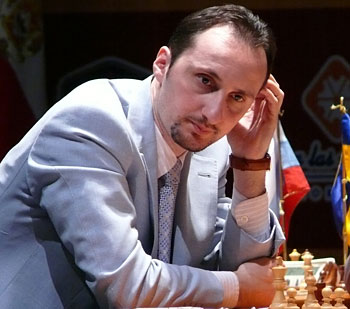
Trying to remember the move order? Veselin Topalov
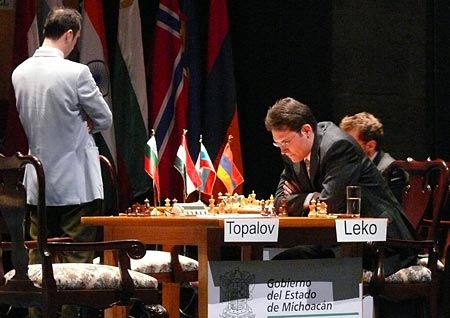
A moment of relaxation for the Bulgarian GM during the game
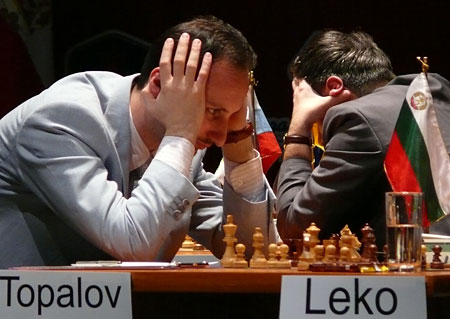
And then back to the board under full pressure (in the background: Ivanchuk)

Magnus Carlsen checking out the progress in this game
Topalov,V (2783) - Leko,P (2749) [E15]
XXIV SuperGM Morelia/Linares MEX/ESP (3), 19.02.2007 [Mihail Marin]
1.d4 Nf6 2.c4 e6 3.Nf3 b6 4.g3 Ba6 5.b3 Bb4+ 6.Bd2 Be7 7.Bg2 c6 8.Bc3
d5 9.Ne5 Nfd7 10.Nxd7 Nxd7 11.Nd2 0-0 12.0-0 Rc8. Deviating from the game
Topalov-Anand from the first round, where 12...Nf6 was played. 13.e4 c5 14.exd5
exd5 15.dxc5 dxc4 16.c6 cxb3 17.Re1 b2 18.Bxb2 Nc5 19.Nb3. One of Topalov's
most memorable games went 19.Nc4 Bxc4 20.Qg4 Bg5 21.Qxc4 Nd3 22.Ba3 Nxe1 23.Rxe1
Re8 24.Rxe8+ Qxe8 25.Bd5 Topalov-Anand, San Luis 2005. White willingly entered
a position where he is an exchange down, without having any immediate threats.
The further course of the game justified Topalov's opening play, although Anand
managed to survive miraculously. 19...Nd3 20.Re2 Nxb2. We can suppose
that Topalov had found an improvement over 20...Bb4 , whcih soon led to a draw
in Nielsen-Leko, Monte Carlo 2006. 21.Rxb2 Qxd1+ 22.Rxd1.
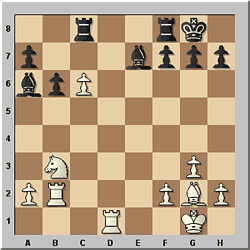
2...Rfd8. A logical novelty. Black simplifies his defensive task by
exchanging rooks. Previously 22...Bf6 had been played. 23.Rbd2 Rxd2 24.Rxd2
Rd8 25.Rxd8+ Bxd8. Black is out of danger here. The pair of bishops keep
the white knight and the far advanced pawn under control. 26.Nd4 Bc4 27.a4
Kf8 28.Nb5 Practically forcing a draw. White had to hurry with provoking
this exchange, because otherwise the centralisation of the enemy king would
have endangered the c-pawn. 28...Bxb5 29.axb5
The rest of the game was played by inertia, or, to be more precise, according
to the Sofia rule. 29...Ke7 30.f4 Bc7 31.Kf2 h6 32.h4 f5 33.h5 Kf6 34.Bf1
Bd6 35.Ke3 Bc7 36.Kd4 Bd6 37.Kd5 Bc7 38.Bd3 Bb8 39.Bc2 1/2-1/2. [Click
to replay]
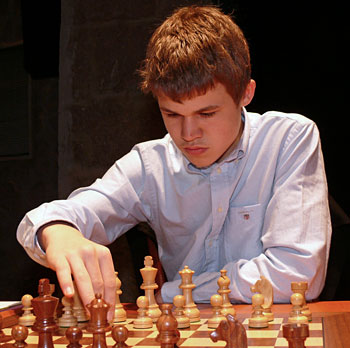
Magnus Carlsen at the start of his round three game against Anand...
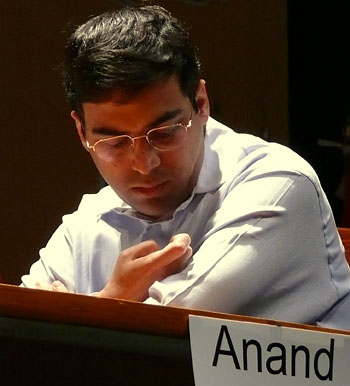
... who coolly checks his nails during the game
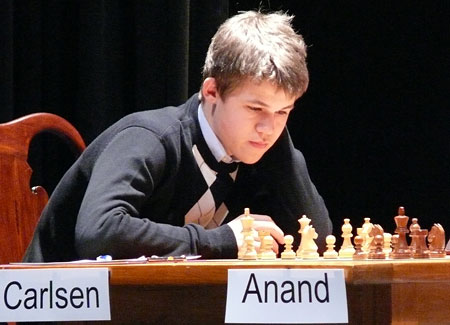
The 16-year-old at work...
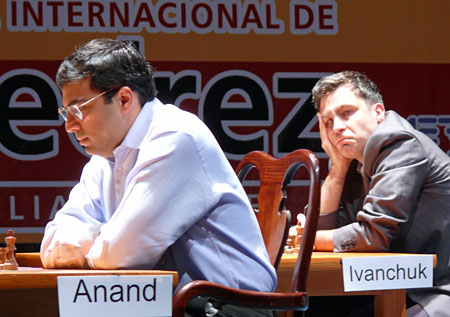
... with Anand under the watchful eye of Vassily Ivanchuk
Carlsen,M (2690) - Anand,V (2779) [D47]
XXIV SuperGM Morelia/Linares MEX/ESP (3), 19.02.2007 [Mihail Marin]
1.d4 d5 2.c4 c6 3.Nc3 Nf6 4.e3 e6 5.Nf3 Nbd7 6.Bd3 dxc4 7.Bxc4 b5 8.Bd3
Bd6!?
This interesting move was introduced in practice by Zviagintsev in the early
'90s, but has never been in the centre of the theoretical disputes. Adopting
it for this specific game must have been an over-the-board decision of Anand,
possibly based on the fact that Carlsen had never played the the Meran variation
(6.Bd3) before.
9.0-0. The only game where Anand had played this line before went
9.Bd2 0-0 10.Ne4 Nxe4 11.Bxe4 Bb7 12.Rc1 Rc8 13.b4. White has delayed his castle,
for the sake of rapid queenside developemnt, aimed to prevent the typical counterplay
based on ...c5. 13...Qe7 14.Qb3 e5 15.dxe5 Nxe5 16.Nxe5 Bxe5 17.Qb1 g6 . It
might seem that White's strategy has been dubious, because castling is connected
with a loss of pawn now. However, after 18.0-0!? Qd6 19.Bc3 Bxh2+ 20.Kh1 Be5
21.Rfd1 White had excellent compensation in view of the passive b7-bishop and
the imobility of the black queenside, Sokolov-Anand, Wijk aan Zee 2005.] 9...0-0
10.b3. Carlsen opts for a quiet way of developing. Several other moves
have been tried here, with no definitive conclusion yet. It should be said that
the most principled line 10.e4 e5 11.Bg5 exd4 12.Nxd4 Ne5 13.Be2 has yielded
Black excelent results in practice. 10...Bb7 11.Bb2 a6 12.Ne4 Nxe4 13.Bxe4.
13...Nf6. Curiously, this natural move is a novelty, which is quite suggestive
for the unsettled character of theory in the Zviagintsev line. 13...f5 has been
occasionally played before, but it is hard to understand why would Black weaken
the a1-h8 diagonal so easily.
14.Bc2 c5 15.dxc5 Bxc5 The position is almost
symmetrical. By having adopted the modest method of development based on b3 (compared
to Black's ...b5 and ...a6), White has spared a tempo, which offers him some chances
of taking over the initiative. However, in the long run the light-squared bishop
will face difficulties achieving stability, precisely because the b3-square is
not available.
16.Ng5. This knight jump might be premature. I would prefer
continuing the development with 16.Qe2 followed by Rfd1 and Ng5 and/or a4.
16...Qxd1.
17.Raxd1?! Quite illogical. The queen's rook is "designed" to
occupy the c-file, eventually after provoking a weakening of the enemy queenside
by means of a4. 17.Rfxd1 Kh8 18.a4 looks like a better continuation. Yet, this
general aspects might seem irrelevant, since Black faces problems defending his
kingside.
17...Kh8! This elegant defence solves Black's problems. 17...h6?!
would have lost apawn after 18.Bxf6 gxf6
(or
18...hxg5 19.Bxg5 with
the same result.
) 19.Nh7 Rfd8 20.Be4!? Bxe4 21.Nxf6+ Kg7 22.Nxe4 without
any compensation for Black.
18.g3. It is hard to comment on this move.
White spends a valuable tempo on... weakening the f3-square. Probably, Carlsen
wanted to make the threat of winning a pawn with Bxf6, which would not work now.
If 18.Bxf6 gxf6 19.Nxh7? then 19...Rg8 20.g3 Kg7 trapping the knight. Instead
of 19.Nxh7, White has several ways of reaching a drawn opposite coloured bishop
ending: 19.Ne4, 19.Be4 or 19.Rd7. Curiously, the engines like 18.g3, too, in fierce
competition with... 18.g4.
18...h6 19.Bxf6 hxg5 20.Bb2. Another drawback
of 18.g3 can be seen in theline 20.Bxg5? f6 , trapping the bishop.
20...Rac8
21.Rc1. Practically admitting the inaccuracy of his 17th move.
21...Rfd8
22.Rfd1 Bf3 23.Rxd8+ Rxd8.
White's temporary initiative has been extinguished completely and now he has to
endure the consequences of his superficial strategy. The f3-bishop is dominating
the board, while his white colleague occupies a passive position on c2. In the
long run, the massive advance of the kingside pawns is likely to increase Black's
advantage. And yet, in symmetrical positions the drawish zone is quite wide and
White should not be in too big danger of losing yet.
24.a3 b4. Of course!
The c2-bishop will not be allowed to get to b3.
25.a4 f5 26.Kf1.
26...f4. This active move will be crowned by success after Black's mistaken
answer. In case of the more static 26...g4 White would have activated his play
with 27.Ke1 Bd6 28.Bd1 Bb7 29.a5 followed by Be2. Black's advantage after 29...Kg8
30.Be2 Kf7 31.Bc4 g5 would be more of symbolic nature.
27.Be4? Instead
of panicking, White should have put the enemy king under pressure, too, with 27.gxf4
gxf4 28.exf4 Rd2 29.Bg6 when in view of the weaknes of the 8th rank Black seems
to have nothing better than a perpetual.
27...Bxe4 28.Rxc5 Rd1+ 29.Ke2 Rb1
30.Bc1 f3+ 31.Kd1 Rxb3.
How much different is this rook and opposite coloured bishops ending from that
from Carlsen's first round game against Morozevich... White has little hope
of surviving. 32.Rc4 Bd3 33.Rc8+ Kh7 34.e4 Rb1 35.Kd2 Bxe4 36.Ke3 Bd5 37.Bd2
Rb3+ 38.Kd4 Rb2 39.Be3 Re2 40.Rc1 Ba2 0-1. [Click
to replay]
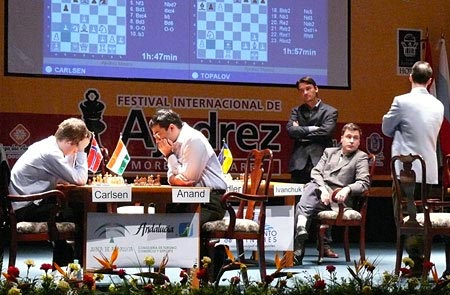
Carlsen, Anand, Morozevich (standing), Ivanchuk and Topalov during the games
Morozevich,A (2741) - Aronian,L (2744) [D38]
XXIV SuperGM Morelia/Linares MEX/ESP (3), 19.02.2007 [Mihail Marin]
1.d4 Nf6 2.c4 e6 3.Nf3 d5 4.Nc3 Bb4 5.cxd5 exd5 6.Bg5 Nbd7 7.e3 c5 8.Be2
Qa5 9.0-0 0-0.
10.Nd2!? A new move. Of course, Morozevich does not allow such details
as the looss of a pawn to distract him from his plans.
10...Bxc3 11.bxc3 Qxc3
12.Rc1 Qa3 13.dxc5 Qxa2 14.Bf4 Re8 15.Nf3 Ne4 16.Bb5 White's better development
and the control over the dark squares offers him excellent compensation.
16...a6
The importance of this move will become clear soon.
17.Ba4!? Very
ambitious. 17.Bxd7 would have led to approximate equality after 17...Bxd7 18.Ra1
Qb2
(18...Qc4?! would lose the exchange after
19.Ne5) 19.Qxd5=.
17...Nexc5 18.Rxc5 Nxc5 19.Bxe8 Be6.
It suddenly appears that White's extra-bishop is trapped. The control over the
b5-square is essential for the net surrounding the bishop. However, White has
not exhausted his resources yet.
20.Be5 Rxe8 21.Bxg7 Kxg7. After the weakening
of the kingside dark squares, Black should not allow this bishop remain on board.
22.Qd4+ Kg8 23.Qxc5 Qc4 24.Qd6.
In spite of the radical structural modifications and some simplifications, the
evaluation of the position remains the same: the weakness of the dark squares
offers White sufficient compensation. The knight is much stronger than the bishop,
but the queenside pawns should not be underestimated. Just remember the second
game from the Elista match...
24...Rc8 25.h3 Qc7 26.Qb4 a5 27.Qh4 Qc2 28.Nd4
Qe4 29.Qe7 b6 30.Kh2 Bf5. The transfer of the bishop to g6 does not seem like
a good idea, as it will provide White with a simple attacking plan. However, Black's
position is not easy to handle. The most difficult thing is to discern between
real threats and imaginary ones.
31.Qf6 Bg6 32.f4. Suddenly, Black is in
great trouble.
32...Qxe3 33.Rf3 Qc1 34.Rg3 Qa1.
35.f5. This is winning, of course, but slightly more precise would have
been 35.h4 , threatening h5-h6 followed by Qg7 mate. In case of 35...h5 , the
move 36.f5 is even stronger than in the game, because the g6-square has been weakened.
I would allow myself a small digression. I am currently involved in our national
championship (which partly explains why my comments are more superficial than
usual). In the same day when the current game was played, I obtained a similar
attacking position against GM Grigore, but failed to convert it into a win because
I did not play h4 at the right moment... However, the coincidence is only relative,
as Morozevich should still win after the game move, although by less obvious means...
35...Rc1 36.Re3 Rh1+ 37.Kg3 Re1 38.Rf3. White had a fantastic attacking
continuation: 38.Qd8+ Kg7 39.f6+ Kh6
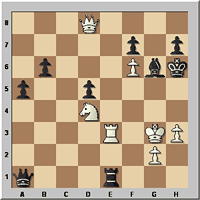
Analysis diagram
40.Kh4!! Taking over the g5- and h5-squares to the enemy king and threatening
mate in one on f8. 40...Qxd4+ 41.g4 and it is all over. 38...Rf1 39.fxg6?
Finally allowing Black to escape dry out of the deepest water. 39.Qd8+
would have still won, in similar way as in the rpevious variation. 39...Rxf3+
40.Qxf3 Qe1+ 41.Kf4 hxg6 42.Qxd5 Qf2+ 43.Nf3. After 43...Qxg2 White will
not have sufficient pawns left to retain winning chances. 1/2-1/2. [Click
to replay]

Very close to a brilliant win: Alexander Morozevich
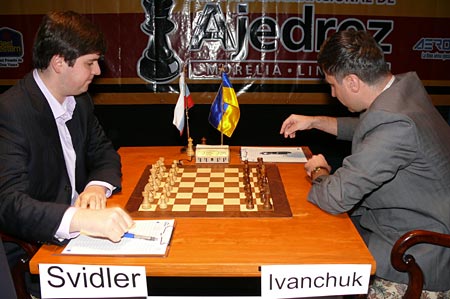
The start of the game Peter Svidler vs Vassily Ivanchuk
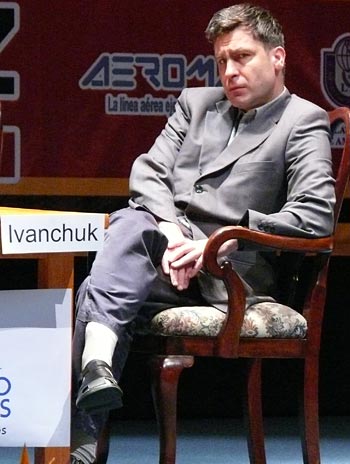
and during the game: Ivanchuk in thinking mode
Svidler,P (2728) - Ivanchuk,V (2750) [C42]
XXIV SuperGM Morelia/Linares MEX/ESP (3), 19.02.2007 [Mihail Marin]
1.e4 e5 2.Nf3 Nf6 3.Nxe5 d6 4.Nf3 Nxe4 5.d4 d5 6.Bd3 Bd6 7.0-0 0-0 8.c4 c6
9.Re1 Bf5 10.Qb3.
Both players had some experience with this position. Black has achieved some
activity in the centre, but faces some problems completing the development of
his queenside. As it so often happens, developing the bishop earlier than the
knight leaves the b7-square vulnerable.
10...Qd7. A relatively rare move, which from the point of view of the
general rules of development might seem a bit paradoxical. Black moves his queen
before developing the knight, blocking the d7-square at the same time. In doing
so, he relies on the fact that White does not dispose over simple means of developing
his initiative, partly because of the active placement of the black minor pieces
in the centre. The more common continuation is 10...Na6 , indirectly defending
the b7-pawn (11.Qxb7 would be met by 11...Nb4). However, in the long run the
knight might remain passive on the edge of the board. Ivanchuk had his first
contact with this position 14 years ago: 11.cxd5 (In a more recent game,
Svidler preferred 11.Nc3 dxc4 12.Bxc4 Nxc3 13.bxc3 b5 14.Bf1 Nc7 15.Bg5 Qc8
16.Bh4 a5 17.Bg3 a4 18.Qb2 Bxg3 19.hxg3 Nd5 20.c4 bxc4 21.Bxc4 with easier
play for White, who went on winning a long ending, Svidler-Morozevich, San Luis
2005.) 11...cxd5 12.Nc3 Bb4 13.Nxe4 dxe4 14.Bxe4 Bxe1 15.Bxf5 with interesting
play in Anand-Ivanchuk, Amber-blind 1993. White has excellent compensation for
the exchange, in view of his active pair of bishops and better coordination
of forces. Apparently, Ivanchuk liked White's play in this game, since he later
tried it himself. However, Black deviated with 12...Be6, when White retained
a small plus with 13.Nb5, Ivanchuk-Shirov, Monte Carlo 2000.
11.Nc3 Nxc3 12.Bxf5 Qxf5 13.Qxb7!? This is the first game in which
White decides to capture this pawn, although the move has been suggested in
some comments already. Earlier this year, Svidler failed to obtain any significant
advantage after 13.bxc3 b6 14.cxd5 cxd5 15.Ba3 Bxa3 16.Qxa3 Nc6 17.h3 Qd7 18.Ne5
Nxe5 19.Rxe5 Rae8 20.Rae1 Re6 21.Rxe6 and a draw was agreed in Svidler-Kramnik,
Wijk aan Zee 2007. 13...Qd7 14.Qxd7 Nxd7.
15.c5. The series of intermediate moves continues. After the neutral 15.bxc3
dxc4 16.Nd2 Nb6 Black enjoys stability on light squares.
15...Bxh2+!?
An instructive moment. Black's central pawns are not weak, but could become so
if any of the c5- or d4-squares would become available to the white minor pieces.
The move played by Ivanchuk is the only one to avoid such a situation. For instance,
if 15...Bxc5 16.dxc5 Ne4 then 17.Nd4 Ndxc5 18.f3 Nf6 19.Nxc6 with better chances
for White.; Or, similarly, 15...Ne4 16.cxd6 Nxd6 17.Bf4 Ne4 18.Rac1 and Black
will probably have to play ...c5 anyway.
16.Nxh2 Ne4 17.Bf4 Rfe8 18.f3 Nef6
19.Nf1 Nf8.
The position remains complicated. The pawn structure is rather assymetrical, while
the force of the white bishop cannot be evaluated unilaterally. In principle,
it puts some pressure on Black, but its activity is restricted by the own central
pawns, which could transform it in a "bad" bishop in case of mass simplifications.
Another important aspects is the hidden weakness of the c6- and d4-pawns. Neither
of them is in imemdiate danger, but they need permanent care.
20.Rxe8 Rxe8
21.Rd1 Re7 22.Nd2 Ne6 23.Be5 a5 24.Nb3 Ra7 25.a4. Blocking the a5-pawn on
a dark square, but ruining the flexibility of the own structure at the same time.
25...Nh5. Untill now, Black has been defending. Once the queenside situation
has been stabilized, he starts active operations on the other wing, where he has
a mobile pawn majority.
26.Re1 h6 27.Kf2 Nhf4 28.Re3 h5 29.g3. White prevents
the blocking move ...h4, but weakens the f3-square.
29...Nh3+ 30.Ke1 g5 31.Nc1
g4 32.fxg4 hxg4 33.Rb3 Nhg5.
Black's initiative has reached alarming heights. He only needs to approach with
his king in order to create decisive threats.
34.Bb8!? This was probably
not intended as an active move (the bishop is not doing anything special on b8)
but as a form of preserving it from the exchange operation ...Nf3+xe5 followed
by ...Nxc5. White needs the c5-pawn in order to generate counterplay after the
probable elimination of Black's c6-pawn. 34.Rb8+ Kh7 35.Nb3 would have solved
thisproblem, but helped Black centralise his king at the same time. For instance
35...Kg6 36.Rb6 Kf5 37.Rxc6 f6 38.Bd6 Rh7 and the situation of White's king looks
dangerous.
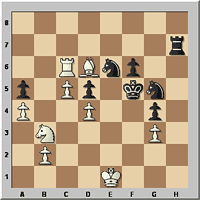
Analysis
diagram
It might all end with a perpetual, but this is hard to foresee during the game.
34...Rd7. 34...Re7 is worth considering. 35.Ne2 Nf3+ 36.Kd1 Nfxd4
37.Nxd4 Nxd4 38.Rb6 Re7 For the time being, Black has managed to keep his
c6-pawn on board, but the knight is stuck on d4, blocking the own d-pawn. 39.b4
axb4 40.a5 Re3 41.Rxb4 Nb5 42.Kd2 Re8 43.Rxg4+ Kh7 44.Bd6 d4 45.Bf4 Ra8 46.Rh4+
Kg7 47.Be5+ f6 48.Rg4+ Kf7 49.Rf4 Ke6 50.Bxd4 Nxd4 51.Rxd4 Rxa5 52.Rd6+ Ke5
53.Rxc6. Finally. 53...Ra3 Admittedly, even in Sofia they would call
it a day. 1/2-1/2. [Click
to replay]

Vishy Anand and Magnus Carlsen analyse in the press room after the game

Magnus being interviewed by the bulletin editors
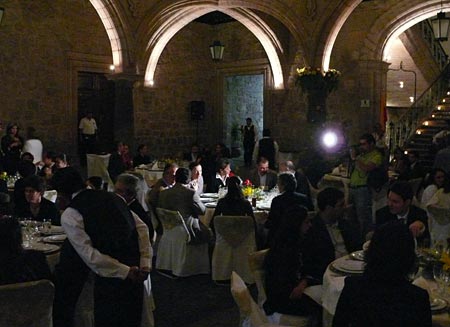
In the evening: a banquet given by the Mayor of Linares
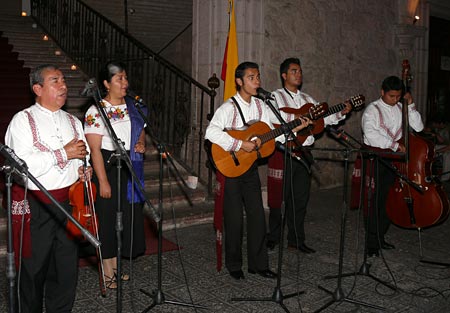
The traditional Mexican band
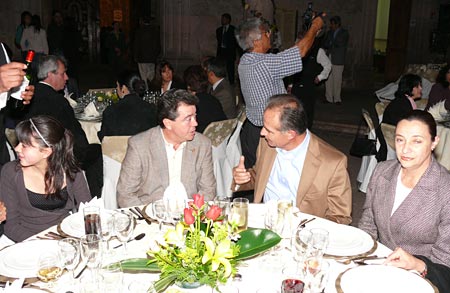
The Mayor's table: Juan Fernandez, Mayor of Linares, is second from left
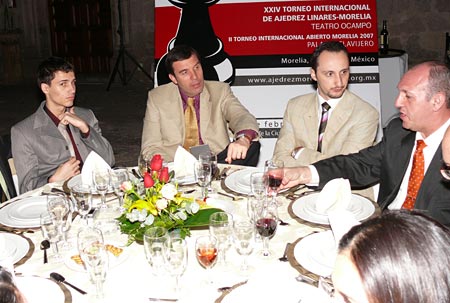
The Topalov team, with Ivan Cheparinov, Silvio Danailov and Veselin Topalov
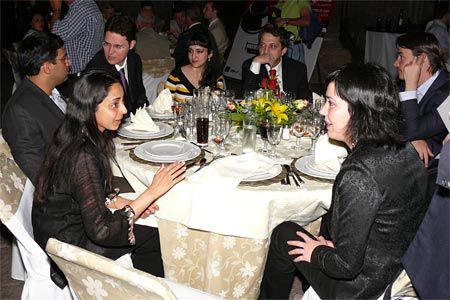
The table shared by Anand, Leko and Morozevich

Straight into the camera – Peter Leko's wife Sofia
Pictures by Frederic Friedel in Morelia
Schedule and results
Round 1: Saturday, February 17th |
| Vassily Ivanchuk |
½-½ |
Peter Leko |
Veselin Topalov |
½-½ |
Vishy Anand |
Peter Svidler |
½-½ |
Levon Aronian |
Magnus Carlsen |
1-0 |
Alex. Morozevich |
|
|
Round 2: Sunday, February 18th |
Peter Leko |
½-½ |
Alex. Morozevich |
Levon Aronian |
½-½ |
Magnus Carlsen |
Vishy Anand |
½-½ |
Peter Svidler |
Vassily Ivanchuk |
1-0 |
Veselin Topalov |
|
|
Round 3: Monday, February 19th |
Veselin Topalov |
½-½ |
Peter Leko |
Peter Svidler |
½-½ |
Vassily Ivanchuk |
Magnus Carlsen |
0-1 |
Vishy Anand |
Alex. Morozevich |
½-½ |
Levon Aronian |
|
|
|
Free day: Tuesday, February 20th |
|
Round 4: Wednesday, February 21st |
Peter Leko |
|
Levon Aronian |
Vishy Anand |
|
Alex. Morozevich |
Vassily Ivanchuk |
|
Magnus Carlsen |
Veselin Topalov |
|
Peter Svidler |
Games – Report |
|
Round 5: Thursday, February 22nd |
Peter Svidler |
|
Peter Leko |
Magnus Carlsen |
|
Veselin Topalov |
Alex. Morozevich |
|
Vassily Ivanchuk |
Levon Aronian |
|
Vishy Anand |
Games – Report |
|
|
Free day: Friday, February 23rd |
|
Round 6: Saturday, February 24th |
Magnus Carlsen |
|
Peter Leko |
Alex. Morozevich |
|
Peter Svidler |
Levon Aronian |
|
Veselin Topalov |
Vishy Anand |
|
Vassily Ivanchuk |
Games – Report |
|
Round 7: Sunday, February 25th |
| Peter Leko |
|
Vishy Anand |
Vassily Ivanchuk |
|
Levon Aronian |
Veselin Topalov |
|
Alex. Morozevich |
Peter Svidler |
|
Magnus Carlsen |
Games – Report |
|
|
Transfer to Linares, Spain |
|
Links


























